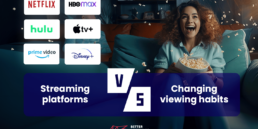According to the reports, the number of Video on demand (VOD) subscriptions for the global market was at $24.9 Billion in 2019 and is expected to scale up to $32.3 Billion by 2025. No wonder the VOD became so popular—people want to watch what they like, how they like and when they like.
Even though traditional TV is still popular, video on demand has become the new normal. So the supply increases with the demand. If you want to know more about VOD than which services offer the latest content, you’re in the right place. Let’s dig right into it!
What Is Video On Demand and How Does It Work?
VOD lets you watch high-definition content on almost any device. It can be a laptop/computer, smartphone, smart TV, or tablet. It’s a system that allows you to stream content that was previously uploaded to a digital library. You can also download it to your device and watch it anytime, anywhere.
It’s convenient because there’s no need to wait for the file to upload. It’s easily accessible right away.
Note that VOD doesn’t mean live streaming. The latter happens in real-time, simultaneously for the live streamer and the viewers. You can read more about live streaming here.
To stream content, either as a viewer or TV provider, you need to have a good Internet connection with enough bandwidth (or in other words, transfer) to gain access to the multimedia. You can stream your content via your favorite remote device or by using a set-top box.
The most popular streaming platforms include Netflix, Hulu, but also, for example, iTunes which offers a wide range of on-demand content, not only videos and movies.
What Do You Need to Launch a VOD Platform?
Introducing a stable, reliable VOD to your servers requires a lot of technical skills and knowledge about the video streaming market. If you want to create a free VOD site with premium features where you can upload your videos for rental, you can do it in three ways:
- The first, and easiest method is to hire specialists who would do the job for you. Such companies have a whole team of specialists who work together to design a solution tailored to your needs.
- You can build the platform from scratch. This method, however, requires a lot of time, people, and money. You’ll need to invest in servers, resources, and other means that would make it possible to maintain a high-quality streaming service.
- Another option is to use VOD software. There are plenty of options to choose from. They fall into two categories: online video platforms (for example, Cincopa, Muvi, Wowza, or Unscreen) that offer a full set of features and work pretty much like template-based platforms. Another category is open-source VOD software (PeerTube, MediaGoblin, or PuMuKIT), a decentralized and free alternative to video broadcasting services that lets you build and custom your own video-on-demand system.
The Three Types of VOD Platforms
Before you start developing your VOD platform, it’s a good idea to think it through. Why? Because it’ll help you deliver the best service.
Consider why you want to have the broadcasting service? What will be its purpose? Whom will it serve? Think about your niche, needs, and how much money can you invest in such an endeavor.
There are three main types of video streaming platforms:
- Commercial entertainment—provide video entertainment as the selection of tv shows or movies.
- Massive open online course (MOOC)—online courses available for anyone with free or paid access like edX or Coursera.
- For individual use within private organizations, public institutions, universities; for people who require it for personal needs to train employees.
Additionally, make sure to know the difference between OTT, IPTV, SVOD, and live streaming. Although some of them are used together, it doesn’t mean it’s the right choice for everyone to implement for their platform. It all depends on your needs and requirements.
The Technical Side of VOD
Are you thinking about launching your own platform with video content? There are several aspects you need to consider.
Whether you’re building it yourself, outsourcing, or using dedicated software, make sure to look for what we’ve got on our list below.
App and website development
To build your platform and serve content to other people you need to have a dedicated virtual space.
It’ll require experienced API engineers, software developers, and tech-savvy people who’ll create the app and website. Additionally, you’ll need UI and UX experts to design a user-friendly environment for video streaming.
Cloud storage
Hosting requires you to have unlimited storage. One of the best is Amazon S2 and S3 cloud storage. It ensures scalability, data availability, security, and high performance. It’s also secure so you can be sure there are no external hazards to your VOD platform.
It’s also possible to store the files on your own server. Remember to ensure top performance for better speed and optimization.
Privacy and encryption standards
Privacy is one of the most important aspects of streaming video content on-demand. Both you and the viewers need to be protected from external inferences.
Ensure top-quality encryption standards to your data and of all the users is protected. One of the most secure encryption types is the Advanced “Encryption Standard” (AES). Then there’s “Rivest-Shamir-Adleman” or (RSA). You can read more on encryption standards here.
Settings for customization
The more flexibility you give the users, the more comfortable they’ll feel. People like to have freedom in how they use, access, and watch content. And you should give them the choice to watch what they like however they like.
Look for customization settings in VOD software that’ll give users the option to adjust their preferences:
- Playback speed control
- Subtitle support
- General settings for the viewer account like privacy, ads options, setting a theme, etc.
- Building personalized playlists
- Picture-in-picture feature and floating window
- Smart recommendations based on AI
- And many more, sophisticated functionalities
When users can choose how they want to use the platform, they’re more likely to subscribe to it.
Video content management
There’s no good VOD platform without CMS (content management system). Make sure to create one to give users full control of what they want to do with the content.
Include categories, tags, quick search, voice search, user-friendly and intuitive navigation, ratings and comments, and other properties that’ll make it easier to discover resources and have quick access to favorite content and most-liked topics.
HTML5 Video Player & Transcoding
Your video player should be able to handle anything you throw at it and anything the viewer wants to watch.
So to make a player that is available for everyone, look for VOD software that allows you to build an HTML5 video player with a transcoding option.
That way, when you upload your video, the player will transcode (convert) the video to different file types, bitrates (video data transfer) and your system will support all major devices and browsers. It’ll also be possible to integrate the platform virtually with any third-party websites, mobile and TV apps.
Generating revenue from your content
If you’re aiming to generate income from a VOD platform, make sure to look out for one of the three possible options:
- Advertising-based video on demand (AVOD)—video content is free for viewers but prior to watching it, they need to view the ads.
- Subscription video on demand (SVOD)—works just like Netflix. Viewers pay to have full access to the content library and watch it any time, anywhere. There are no ads.
- Transactional video on demand (TVOD)— viewers purchase video content to watch for a limited time and number.
And don’t forget to have a payment gateway integrated to be able to process payments!
Summing Up
Creating a VOD platform is like squeezing the whole large library of content into Internet transfer so people can easily choose what they like whenever they want to.
Users seek non-traditional solutions for consuming content. Due to pandemic and shifting tendencies, the market of streaming services will steadily grow. And that is your chance to create a coherent, top-notch video service ecosystem for even the most demanding users.
Just choose your niche, the right VOD software, or hire specialists to do the magic for you. Good luck!
If you find this article valuable, you can share it on social media →
Read more about the VOD & OTT Industry!
April 25, 2024
What is Connected TV and why is it becoming so popular?
Discover the benefits of Connected TV as it transforms entertainment by delivering internet-powered content through smart TVs and streaming devices.
March 7, 2024
7 reasons why is sports streaming becoming so popular
Learn more about the reasons why sports streaming is becoming more and more popular right now.
February 29, 2024
Why should streaming platforms adapt to changing viewing habits?
Discover the strategies through which streaming platforms adjust to changing viewing habits.
Are you looking for a partner to build a Video Solution?
Leave your email and a short description about your project. We would gladly discuss different cooperation possibilities!





